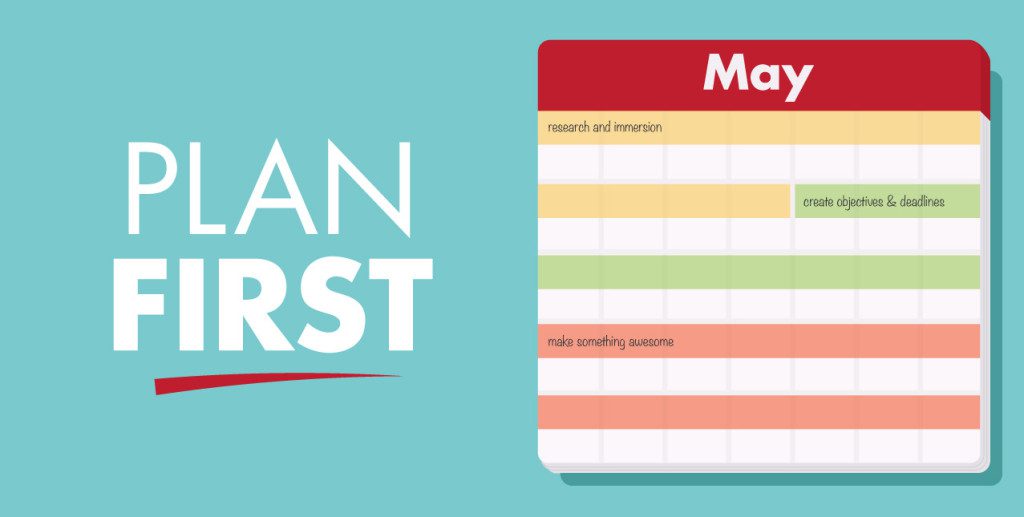Effective Planning in 3 Steps

When it comes to successful marketing, planning matters. In fact, we’re willing to go so far as to say that, without a plan, your efforts won’t be as effective. From posting on social media to building a website, having a plan of attack will ensure you are meeting your objectives and ready for the ups and downs that inevitably come with business.
For many, planning doesn’t come easy — it can feel like an overwhelming and arduous process that takes too long. However, our proven three-step procedure makes it simpler. Try following these tips, and we guarantee it’ll change your perspective on the planning process and prove once and for all that carts should never come before the horse.
Step 1: Do Your Homework
At R&R, we start every project with research and immersion, and that’s because we have to know our client’s business before we can design for it. Imagine what would happen if we just started creating a logo mark before we knew anything about what the business does, who the customers are or where the business is going. It would be like buying a house without asking any questions. You could end up trying to squeeze five people into a one-bedroom, one-bath bungalow on the wrong side of town. Asking questions and doing homework is a huge part of what makes a project successful.
No matter how well you know your company, there’s always value in spending some time stepping back to see the big picture then diving back in to try and see it in a new light. Sure, it might seem tedious, but think about it in terms of a big purchase — cars, homes, dream vacations — you wouldn’t lay out a dollar on any of those things before you looked into them, so why would you do that with your marketing?
Step 2: Create Achievable Objectives
Once you’ve finished research and immersion, you should have a pretty good idea about the who, what, where, why and how of your business. Now you have to determine your marketing objectives. Before you go throwing money around, don’t you want to have a goal for it?
Say your research uncovered that a majority of your target market doesn’t know your company or what it does. Ouch. We’ll let that sting wear off for a moment. OK, now that you swallowed that pill, your objective is to build awareness. Fortunately, awareness is a pretty typical objective — even Coca-Cola has brand building strategies when it enters new markets.
The best objectives are quantifiable and have a hard deadline. For example, Company X’s objective is to increase awareness among the 18- to 24-year-old demographic by 25 percent in 12 months. This way you know what you need to do, how long you have to do it and a quantifiable number to work toward.
Sure it would be great to increase awareness by 100 percent, but that’s simply unrealistic. Another unrealistic idea is to create 50 objectives. No one’s got that kind of time. Instead, stick to a maximum of three so that you can focus your efforts on actually achieving them.
Step 3: Keep Things Manageable and Affordable
It’s easy to look at your objectives and think, “OMG how the @$%*& am I going to achieve them?” It’s even easier if you are looking at them from a 12-month perspective, so our advice is to break things down. Instead of 12 months, why not develop a plan for three months and set a budget for those three months? Phew, that is a lot less scary and a lot more tangible.
Going back to the awareness objective, think about what three things you can do to increase awareness during the next three months. Again, don’t think of 100 things — keep it to a manageable number and affordable price. When the three months is close to wrapping up, start thinking about the next three months and three additional efforts. Write them down and make them happen.
Keep in mind, too, that your short-term, objective-reaching efforts don’t have to cost a fortune. Create a social media content calendar and post regular messages on Facebook. Not into Facebook? Snap photos that are on-brand and on-message for Instagram. Get out of social altogether and send out some eblasts. MailChimp is free for up to 2,000 email addresses, and they have great editable templates.
No matter what, be engaged and stay focused. Before you know it, you’ll be a planning machine. Just remember:
- Do your homework
- Create achievable objectives
- Keep things manageable and affordable

